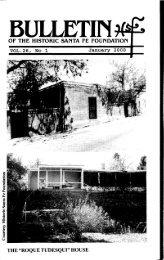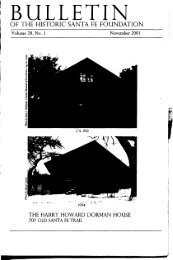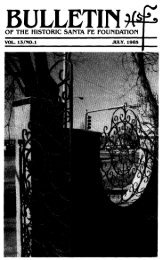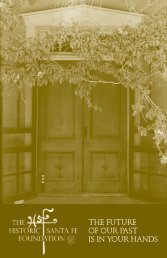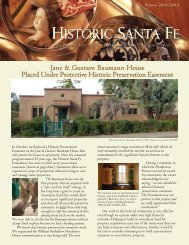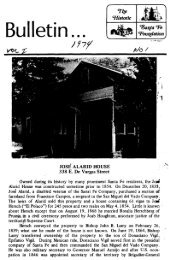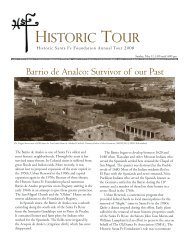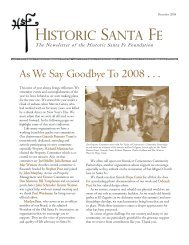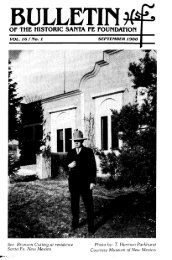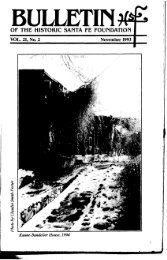Witter Bynner House - Historic Santa Fe Foundation
Witter Bynner House - Historic Santa Fe Foundation
Witter Bynner House - Historic Santa Fe Foundation
You also want an ePaper? Increase the reach of your titles
YUMPU automatically turns print PDFs into web optimized ePapers that Google loves.
BULLETIN<br />
OF THE IIISTORIC SANTA FE FOUNDATION<br />
VOL. 20 / No. 2 September 1992<br />
<strong>Witter</strong> <strong>Bynner</strong> <strong>House</strong>, 1992
.~••<br />
~ z<br />
z<br />
19<br />
(f)<br />
-x<br />
OS<br />
... v7'" 1M of •<br />
0...<br />
--.J III<br />
ct.<br />
--.J •<br />
••<br />
1M Q<br />
LL ,! ;<br />
I<br />
THE WITTER BYNNER HOUSE<br />
Corinne P. Sze, Ph.D.<br />
is a rambling, partially<br />
Thetwo-story <strong>Witter</strong> <strong>Bynner</strong><br />
structure<br />
<strong>House</strong><br />
of<br />
more than 30 rooms located on<br />
the southwest corner of East<br />
Buena Vista Street and the Old<br />
<strong>Santa</strong> <strong>Fe</strong> Trail. It faces north<br />
from the crest of a steep rise at<br />
the south end of a large lot.<br />
Although it incorporates two<br />
older homes, the sum was created<br />
over a period of four<br />
decades by the poet <strong>Witter</strong><br />
<strong>Bynner</strong>.<br />
Not widely known today,<br />
<strong>Bynner</strong> was a major figure in<br />
the American modern poetry<br />
movement of the early twentieth<br />
century. Primarily a lyric<br />
poet, he produced 18 books of<br />
verse in a working life that<br />
spanned over 50 years between<br />
the publication of his first<br />
(1907) and last (1960) works.<br />
He also published poetic translations<br />
from Chinese, French,<br />
and Classical Greek; verse<br />
satire; plays; and prose.<br />
Beginning with a small,<br />
three-room house with little<br />
land and no landscaping,<br />
<strong>Bynner</strong> combined several tracts<br />
to form this large property. By<br />
adding new rooms and incorporating<br />
another existing<br />
dwelling, he increased the size<br />
of his original home tenfold.<br />
He also did extensive landscaping,<br />
constructing stone terrace<br />
walls, concrete benches, flagstone<br />
steps and walkways; plus<br />
planting trees, shrubs, and<br />
flowers, to create the distinctive<br />
grounds that contribute to the<br />
special character of the property.<br />
In its final form, which<br />
remains intact today, the<br />
<strong>Bynner</strong> <strong>House</strong> is a linear structure<br />
of one-story rooms strung<br />
out irregularly from either side<br />
of a central two-story section. It<br />
is Spanish-Pueblo Revival in<br />
character having such defining<br />
elements as a linear, asymmetrical<br />
form; flat roof and irregular<br />
roof lines; canales protruding<br />
from parapet walls; and<br />
unevenly cut, exposed viga<br />
ends. The distinctive feature of<br />
the main facade is the two-story<br />
porch and balcony. On the<br />
interior many rooms have corner<br />
fireplaces and most ceilings<br />
are constructed with exposed<br />
vigas. It appears that no two<br />
rooms are on the same floor<br />
level, so often are there steps<br />
between them.<br />
Harold <strong>Witter</strong> <strong>Bynner</strong><br />
(<strong>Witter</strong> <strong>Bynner</strong> professionally<br />
and Hal to friends) was born in<br />
Brooklyn, New York, in 1881.<br />
After the separation of his parents<br />
(1888) and death of his<br />
father (1891),<strong>Bynner</strong>, his mother<br />
Annie Louise, and brother<br />
lived with relatives first in<br />
Norwich, Conn., and later in
Brookline, Mass. In 1901 his<br />
mother married a successful<br />
businessman, Walter Liveridge<br />
Wellington. A talent for writing<br />
had appeared in earlier<br />
generations of the <strong>Bynner</strong> family;<br />
his grandfather was a newspaper<br />
editor and an uncle was<br />
a historian and the author of<br />
popular American historical<br />
novels.<br />
After his 1902 graduation<br />
from Harvard University,<br />
<strong>Bynner</strong> began a literary career<br />
as an assistant editor at<br />
McClure's magazine in New<br />
York City, editing fiction as<br />
well as poetry. While there he<br />
worked with Lincoln Steffens<br />
and Ida Tarbell and arranged<br />
for the first American publication<br />
of the poetry of A. E.<br />
Housman. He edited Willa<br />
Cather's work and became a<br />
close friend of O. Henry, whose<br />
short stories he secured for the<br />
magazine.<br />
In 1906<strong>Bynner</strong> left McClure's<br />
to concentrate on his own writing<br />
and a year later published<br />
his first book, An Ode to<br />
Harvard and Other Poems. For<br />
the next 10 years he was based<br />
in Cornish, New Hampshire.<br />
Experimenting with other genres,<br />
such as drama, he wrote a<br />
one-act play with Cecil B. De<br />
Mille, composed songs, and<br />
wrote a musical comedy called<br />
Anygirl, which failed in<br />
Brooklyn. To support himself<br />
he lectured throughout the<br />
United States on the subjects<br />
which interested him most:<br />
2<br />
poetry, minority rights, and<br />
suffrage. Later he would refer<br />
to himself during this period as<br />
a "commercialized troubadour."l<br />
His poetry was well<br />
received and <strong>Bynner</strong> became<br />
one of the leading "new poets"<br />
who sought to express everyday<br />
subjects in clear, simple<br />
language.<br />
As he would throughout his<br />
life, <strong>Bynner</strong> established and<br />
maintained friendships with<br />
the leading artists of the time,<br />
poet and Harvard classmate<br />
Wallace Stevens, Mark Twain,<br />
Henry James,BoothTarkington,<br />
and painters John Sloan and<br />
Robert Henri, who were in the<br />
vanguard of artists who "discovered"<br />
<strong>Santa</strong> <strong>Fe</strong> in the early<br />
years of the twentieth century.<br />
He helped Ezra Pound publish<br />
his first book and was a close<br />
friend of Edna St. Vincent<br />
Millay, who accepted his proposal<br />
of marriage although<br />
they both soon thought better<br />
of the idea.<br />
In 1915 <strong>Bynner</strong> translated<br />
the fifth century B.C. Greek<br />
tragedy Iphigenia in Tauris by<br />
Euripides for Isadora Duncan,<br />
who wanted to stage a version<br />
that was not scholarly or stilted.<br />
Although Duncan was<br />
unable to produce the play, in<br />
1956 a polished revision of the<br />
translation was included in the<br />
University of Chicago's distinguished<br />
collection of the complete<br />
Greek tragedies in<br />
English edited by Grene and<br />
Lattimore.
•<br />
<strong>Witter</strong> <strong>Bynner</strong>'s garden, no date.<br />
Modern poetry in the teens<br />
was rife with "schools" bearing<br />
names like "Imagism," "Vorticism"<br />
and "Futurism." Irked<br />
by what he viewed as the silliness<br />
of these schools and their<br />
proponents (the "gists" and the<br />
"cists"), <strong>Bynner</strong> with his closest<br />
college friend, poet Arthur<br />
Davison Ficke, perpetrated one<br />
of the most successful hoaxes in<br />
American literary history.<br />
Their school, "Spectrism," was<br />
centered in unlikely Pittsburgh.<br />
For a year and a half <strong>Bynner</strong><br />
and Ficke published Spectric<br />
poetry under the names<br />
Emanual Morgan and Anne<br />
Knish, respectively. Their work<br />
was praised by critics and seriously<br />
discussed by fellow<br />
poets, often in <strong>Bynner</strong>'s amused<br />
3<br />
presence. The satire was not<br />
recognized until <strong>Bynner</strong> himself<br />
finally revealed the truth.2<br />
In 1917 <strong>Bynner</strong> took the first<br />
of two trips to China that<br />
would affect the rest of his life<br />
and indirectly bring him to<br />
<strong>Santa</strong> <strong>Fe</strong>. In Chinese poetry he<br />
found a brevity and specificity<br />
which influenced his own work<br />
profoundly. He also began collecting<br />
Chinese paintings, jades,<br />
and other art and artifacts that<br />
gave his <strong>Santa</strong> <strong>Fe</strong> home its special<br />
character. During a stint at<br />
Berkeley in 1918,first as a voice<br />
instructor for army officers,<br />
then as a "poet in residence"<br />
after the Armistice, he began a<br />
collaboration with Chinese<br />
scholar Kiang Kang-hu, which<br />
led to the publication 11 years
later of two volumes entitled<br />
The Jade Mountain containing<br />
some 300T'ang poems.<br />
A lecture tour on China<br />
brought <strong>Bynner</strong> to <strong>Santa</strong> <strong>Fe</strong> in<br />
<strong>Fe</strong>bruary 1922 and illness<br />
caused him to linger. He<br />
arranged the lecture schedule<br />
so he could visit two old<br />
friends, painter Willard Nash<br />
and poet Alice Corbin<br />
Henderson, who was a guiding<br />
force of the writers' wing of the<br />
<strong>Santa</strong> <strong>Fe</strong> art colony. <strong>Bynner</strong><br />
had met Corbin when the two<br />
sparred over the relative merits<br />
of Spectrism and Imagism during<br />
a <strong>Bynner</strong> lecture in<br />
Chicago.3 The Palace Hotel<br />
had recently burned<br />
down and <strong>Bynner</strong><br />
was lodged at Sunmount<br />
Sanatorium.<br />
Although he was<br />
himself unwell, he<br />
spoke for two hours<br />
to 70 people in the<br />
Sunmount auditorium<br />
on the theme,<br />
"The Heart of<br />
China."4 Illness<br />
forced him to cancel<br />
the rest of the tour<br />
and he stayed on at<br />
the Sanatorium<br />
longer<br />
weeks<br />
than the six<br />
needed to<br />
recover. There he<br />
took part in the poetry<br />
readings and literary<br />
discussions that<br />
were part of the<br />
Sunmount experi- Frieda Lawrence, <strong>Witter</strong> <strong>Bynner</strong>, and Willard<br />
ence and realized "Spud" Johnson at <strong>Witter</strong> <strong>Bynner</strong>'s house ca. 1923<br />
4<br />
that he would like to make his<br />
permanent home in <strong>Santa</strong> <strong>Fe</strong>.<br />
<strong>Bynner</strong> was 41 when he<br />
came to <strong>Santa</strong> <strong>Fe</strong> and until then<br />
had led a somewhat unsettled<br />
life. Upon leaving Sunmount<br />
he rented a small adobe home<br />
from the recently widowed<br />
painter Paul Burlin. This he<br />
later purchased and greatly<br />
enlarged with new construction<br />
as well as the addition of contiguous<br />
land and a neighboring<br />
house to create the present<br />
structure, his home for the<br />
remainder of his 86 years.<br />
During his first September in<br />
New Mexico, D.H. and Frieda<br />
Lawrence were brought by<br />
------ Q l::<br />
...<br />
1I<br />
~<br />
~<br />
;;:-<br />
...<br />
~ ;:!<br />
;:!<br />
'"<br />
...<br />
~<br />
l::<br />
;:!<br />
to'<br />
;:!<br />
"0-<br />
...<br />
cl'<br />
'"<br />
~
Mabel Dodge Luhan of Taos to<br />
spend their first night in New<br />
Mexico under <strong>Bynner</strong>'s roofamong<br />
the first of numerous<br />
artists who would enjoy the<br />
hospitality of <strong>Bynner</strong>'s horne.<br />
That spring he traveled with<br />
the Lawrences to Mexico and<br />
first visited Chapala, where he<br />
would spend a part of nearly<br />
every year. In 1940he bought a<br />
horne there, which he renovated<br />
and greatly enlarged.<br />
<strong>Bynner</strong> was the source of a<br />
minor character in Lawrence's<br />
The Plumed Serpent and in 1951<br />
published a prose account of<br />
the trip entitled, "Journey With<br />
Genius." His relationship with<br />
Mabel Dodge Luhan soon deteriorated<br />
into a malicious rivalry<br />
and he satirized her in a 1926<br />
verse play, Cake:An Indulgence.<br />
In <strong>Santa</strong> <strong>Fe</strong> <strong>Bynner</strong> found a<br />
stimulating intellectual atmosphere<br />
combined with a refreshingly<br />
"simple" life and an easygoing<br />
acceptance of the unconventional.<br />
He became a leader<br />
of the literary colony and his<br />
horne was the center of a prodigious<br />
social life. He cut an<br />
unusual figure, even among<br />
<strong>Santa</strong> <strong>Fe</strong>'s unconventional<br />
artists, often dressing in<br />
Chinese robes or Navajo shirt<br />
and concha belt. His schedule<br />
was also his own. He habitually<br />
worked at his desk until<br />
dawn and then perhaps gardened<br />
before going to bed. He<br />
breakfasted at about one<br />
o'clock and then worked until<br />
the late afternoon when he was<br />
S<br />
ready to receive guests. A sign<br />
on his door made by John Sloan<br />
announced that no one should<br />
call before five in the evening.<br />
One could, however, remain<br />
until any hour after which<br />
<strong>Bynner</strong> would write until daylight.<br />
His parties were legend<br />
and he was particularly remembered<br />
for- entertaining at the<br />
piano with songs sometimes<br />
composed on the spot and often<br />
bawdy. It was said that everybody<br />
who was anybody visited<br />
his horne when in <strong>Santa</strong> <strong>Fe</strong>.<br />
<strong>Bynner</strong> was deeply interested<br />
in politics and said that to<br />
him "poetry and politics were<br />
the two most important things<br />
in the world."s Throughout his<br />
life he championed the rights of<br />
women and minorities. While<br />
at Harvard and in succeeding<br />
decades, he actively campaigned<br />
for women's suffrage.<br />
A 1911 photograph shows him<br />
and John Dewey leading the<br />
men's contingent of a suffrage<br />
parade down Fifth Avenue. In<br />
New Mexico he continued his<br />
interest in politics and was a<br />
dedicated advocate for the<br />
rights of American Indians. He<br />
strongly supported Senator<br />
Robert LaFollette's 1924<br />
Progressive Party candidacy for<br />
president and in 1926 ran<br />
unsuccessfully as a Democratic<br />
candidate for the State<br />
Legislature.6 In 1937 while in<br />
Mexico he met with Trotsky,<br />
the exiled Russian revolutionary,<br />
whom he had met years<br />
before in Greenwich Village.
Trotsky, knowing of <strong>Bynner</strong>'s<br />
membership in the American<br />
Committee for the Defense of<br />
Leon Trotsky, sought his help<br />
in re-entering the United<br />
States.?<br />
In <strong>Santa</strong> <strong>Fe</strong> he could be<br />
counted on to forcefully speak<br />
at meetings on issues of concern<br />
to artists. Active in the<br />
successful campaign to prevent<br />
the <strong>Fe</strong>derated Women's Clubs<br />
of the Southwestern States from<br />
establishing a summer "culture<br />
colony" in <strong>Santa</strong> <strong>Fe</strong>, he wrote a<br />
long article for the New York<br />
Times explaining the opposition.8<br />
He was a prime mover in<br />
the Pasatiempo-Fiesta activities<br />
that the artists devised as<br />
an alternative to the more formal<br />
ceremonies staged for the<br />
price of admission by the<br />
Museum of New Mexico and<br />
the Chamber of Commerce.<br />
For years <strong>Bynner</strong>, an exceptionally<br />
tall man, led the Fiesta<br />
parade with John Sloan's<br />
diminutive wife, Dolly.<br />
In 1930Robert Nichols Hunt,<br />
whom <strong>Bynner</strong> had met four<br />
years earlier through Paul<br />
Horgan, came for a visit and<br />
remained with <strong>Bynner</strong> until his<br />
(Hunt's) death in 1964. Hunt,<br />
then 24 years old, was the son<br />
of Myron Hunt, one of southern<br />
California's foremost architects-designer<br />
of the Hollywood<br />
Bowl, the Rose Bowl, and<br />
the Huntington Library in San<br />
Marino.9 Robert Hunt, who<br />
had worked briefly for his<br />
father's firm, evidently had a<br />
6<br />
<strong>Witter</strong> <strong>Bynner</strong> & his mother, Annie<br />
Louise Wellington, at his new home in<br />
<strong>Santa</strong> <strong>Fe</strong>, 1922.<br />
talent for architecture although<br />
he never practiced formally.<br />
He designed rooms for<br />
<strong>Bynner</strong>'s home, alterations to<br />
the Chapala house, and a living<br />
room for the Peter Hurd ranch<br />
in San Patricio. Hunt created<br />
the house on San Acacio Street<br />
which, through a gift from<br />
<strong>Bynner</strong>, is now the St. John's<br />
College president's house. He<br />
also served as <strong>Bynner</strong>'s business<br />
manager, edited his work,<br />
and took care of him as he grew<br />
into old age. Also a poet in his<br />
own right, Hunt published a<br />
book of verse in 1936,the same<br />
year that he assembled and<br />
edited <strong>Bynner</strong>'s Selected Poems.
<strong>Bynner</strong>'s passion for collecting<br />
led him to acquire great<br />
numbers of objects which he<br />
used to adorn his home. In<br />
China he collected paintings, of<br />
which 139 examples on silk or<br />
paper were exhibited in a special<br />
showing in <strong>Santa</strong> <strong>Fe</strong> in<br />
1928.10 He also amassed over<br />
300 Chinese carved girdle<br />
clasps, or belt buckles made<br />
mostly of jade but also of other<br />
materials, such as chalcedony,<br />
jasper, ivory, amber, brass,<br />
wood, and Peking glass, each<br />
on its own teakwood stand.l1<br />
In 1953 he gave portions of his<br />
collection of oriental art to the<br />
Roswell Museum.12<br />
Shortly after his arrival in<br />
<strong>Santa</strong> <strong>Fe</strong>, <strong>Bynner</strong> was given a<br />
silver Indian bracelet by<br />
Willard Nash. Intrigued, he<br />
began collecting Indian-made<br />
jewelry with his usual fervor.<br />
In the 1920s he formed the<br />
Spanish- Indian Trading Company<br />
with the painter Andrew<br />
Dasburg, Mabel Dodge Luhan's<br />
son John Evans, and others. At<br />
their store across from La<br />
Fonda they successfully sold<br />
jewelry and other handmade<br />
items weeded from their own<br />
collections or purchased on frequent<br />
buying trips. For 25 years<br />
extensive loaned displays from<br />
<strong>Bynner</strong>'s personal collection<br />
formed the nucleus of exhibits<br />
of American Indian jewelry at<br />
the Museum of New Mexico.<br />
In 1954 he deeded an impressive<br />
collection of 222 Navajo<br />
and Pueblo pieces to the School<br />
7<br />
of American Research and in<br />
1956added 130examples of his<br />
"better pieces."13<br />
After settling in <strong>Santa</strong> <strong>Fe</strong>,<br />
<strong>Bynner</strong> continued to publish<br />
poetry, plays, satire, translations,<br />
and less frequently,<br />
prose. His national recognition<br />
as a poet peaked in the 1920s<br />
coinciding with the popularity<br />
of lyric poetry. Thereaft~r,<br />
poetic fashion turned towa.rd<br />
less accessible artists like Ezra<br />
Pound and T.S. Eliot.<br />
Nevertheless, he continued<br />
until 1960 to regularly publish<br />
volumes of poetry, which we.re<br />
nationally reviewed.<br />
of satire contInued<br />
The vein<br />
with his<br />
1935 Guest Book, a collection of<br />
poems each pottraying an<br />
unnamed specific friend or<br />
acquaintance as a type, such as<br />
the Debutante, Communist,<br />
Ghost, Gourmand, Poetess, or<br />
Spouse. Among his subjects<br />
were Thornton Wilder, Amy<br />
Lowell, Carl Van Vechten, Max<br />
Eastman, Robinson Jeffers, and<br />
of course Mabel Dodge Luhan.<br />
In 1944 he published his most<br />
popular work, his version of<br />
Laotzu entitled The Way of Life<br />
According to Laotzu, which had<br />
been refused by Knopf, his<br />
usual publisher, for fear that it<br />
would not be successful.<br />
The <strong>Bynner</strong> <strong>House</strong> grew<br />
from a three-room adobe<br />
dwelling first rented from Paul<br />
Burlin in June of 1922.l4 In 1920<br />
Budin's wife, Natalie Curtis,<br />
had purchased from Adela<br />
Rivera de Alarid, a house con-
sisting of "two rooms and a<br />
hall" on a small interior lot<br />
with a IS-foot-wide access to<br />
College Street.15 The Burlins<br />
soon added a kitchen to the original<br />
two rooms.16<br />
Paul Budin, who had<br />
arrived in <strong>Santa</strong> <strong>Fe</strong> in 1913,was<br />
an early member of <strong>Santa</strong> <strong>Fe</strong>'s<br />
art colony. An exhibitor in the<br />
Armory Show of 1913, he represented<br />
the avant-garde<br />
among <strong>Santa</strong> <strong>Fe</strong>'s artists, painting<br />
traditional New Mexican<br />
subjects in impressionistic and<br />
semi-abstract style.17 He married<br />
Natalie Curtis in <strong>Santa</strong> <strong>Fe</strong><br />
in 1917.18<br />
Curtis was from a prominent<br />
New England family that had<br />
produced two presidents of<br />
Harvard University. Her<br />
father, Dr. Edward Curtis, was<br />
an eminent New York physician<br />
and medical researcher<br />
who, in his youth, had assisted<br />
at the autopsy of President<br />
Lincoln.19 Trained as a concert<br />
pianist, she was inspired by a<br />
visit to Arizona to undertake<br />
the recording of American<br />
Indian songs at a time when<br />
federal government policy was<br />
attempting to eradicate native<br />
languages and songs. A pioneer<br />
in the field of ethnomusicology,<br />
she published painstakingly<br />
achieved transcriptions of<br />
Native American, African<br />
American, and Native African<br />
music and folklore.2o Curtis<br />
was also able to effectively convey<br />
to President Theodore<br />
Roosevelt as a personal friend<br />
8<br />
her concern for the destruction<br />
of indigenous American culture.21<br />
On October 23, 1921,<br />
Curtis was fatally struck by a<br />
Parisian taxicab just after she<br />
had delivered an address at the<br />
Sorbonne.22The-followingJune<br />
Paul Burlin rented his <strong>Santa</strong> <strong>Fe</strong><br />
home to <strong>Witter</strong> <strong>Bynner</strong>. Burlin<br />
eventually returned to his<br />
native New York City and<br />
enjoyed a long and successful<br />
career as a painter.23<br />
<strong>Bynner</strong> immediately set<br />
about making the house his<br />
own. ByJuly he had decorated<br />
the living room with Chinese<br />
paintings and was enjoying the<br />
impression they made on visitors.24<br />
There was also a "little<br />
shack outside of the house just<br />
big enough for a fellow to live<br />
in" where a painter from<br />
Berkeley briefly stayed.25<br />
<strong>Bynner</strong> began to contemplate<br />
buying the property and<br />
expressed his infatuation with<br />
it to Alice Long, the wife of his<br />
friend, writer Haniel Long:<br />
Softly just between ourselves,<br />
let me whisper<br />
that I begin to think of<br />
buying the little house I<br />
inhabit if I can bring the<br />
owner down to about half<br />
of what he asks for it.<br />
There is a hand's breath<br />
of land belonging to it...its<br />
own pink lines crumbling<br />
though they be are something<br />
I have dreamed and<br />
its three quaint rooms,<br />
leaks and all are surely<br />
fashioned with a wand.
"'<br />
Nobody else will ever like<br />
it as well as I like it and no<br />
other part of America is so<br />
rewarding.26<br />
To his deep disappointment,<br />
while he was renting the house<br />
and formulating plans for its<br />
enlargement and decor (and<br />
perhaps hesitating too long<br />
over the price), it was sold for<br />
$2,500 to Margretta Dietrich of<br />
Hastings, NebraskaP A reluctant<br />
Dietrich was finally prevailed<br />
upon to sell the house to<br />
<strong>Bynner</strong> who officially assumed<br />
ownership of this first segment<br />
of the property on March 7,<br />
1925.28 Dietrich went on to purchase<br />
and restore three Canyon<br />
Road properties, the Prada<br />
<strong>House</strong>, the Borrego <strong>House</strong>, and<br />
EI Zaguan, all plaqued by the<br />
<strong>Historic</strong> <strong>Santa</strong> <strong>Fe</strong> <strong>Foundation</strong><br />
and the latter now owned by<br />
the <strong>Foundation</strong>.<br />
<strong>Bynner</strong> immediately began<br />
working on the house in<br />
earnest, "touching it up" now<br />
that it was at last his.29 The "little<br />
shack" he "fitted up" for a<br />
comfortable study away from<br />
the house and constructed a<br />
storeroom alongside the outhouse.<br />
He added a bay window<br />
in the studio and had<br />
heavy white curtains woven in<br />
Mexico for it.30 It appears that<br />
the original Curtis/Burlin<br />
rooms on the property were<br />
included in what are now<br />
Rooms 203,204,205,and 206.<br />
Within months <strong>Bynner</strong><br />
enlarged the property with purchases<br />
of tracts adjoining on the<br />
Ansel Adams photo of <strong>Bynner</strong>, no date.<br />
9
west and north from Harry<br />
Dorman,31 who owned all of<br />
the surrounding land with the<br />
exception of a parcel on the<br />
north and the tract directly to<br />
the east, which included another<br />
home. The next summer<br />
(1926)he extended his property<br />
to Buena Vista Street by purchasing<br />
from Dorman the large<br />
corner tract north of the<br />
house.32 Dorman lived across<br />
College Street (Old <strong>Santa</strong> <strong>Fe</strong><br />
Trail) from the <strong>Bynner</strong> property<br />
on the corner of West Buena<br />
Vista Street (Camino de las<br />
Animas). On this last and<br />
largest parcel that he sold to<br />
<strong>Bynner</strong>, Dorman had stabled<br />
his children's<br />
horses.33<br />
At about the<br />
same time, <strong>Bynner</strong><br />
began the foundation<br />
for a twostory<br />
addition<br />
"just off of the corner<br />
door of the<br />
study" fronted by<br />
a porch and balcony<br />
supported<br />
by four round<br />
posts on each<br />
floor. It consisted<br />
of three new<br />
adobe rooms, a<br />
concrete-lined<br />
vault and a lavatory.<br />
The upstairs<br />
study (Room 215)<br />
was to be "away<br />
tains."34 By November of 1927<br />
<strong>Bynner</strong> was sleeping in his new<br />
bedroom (Room 308).35 The<br />
large front room, called the<br />
"library," on the first floor of<br />
the addition (Room 202) was<br />
lined with books from floor to<br />
ceiling and also served as the<br />
main living room where guests<br />
were entertained. The former<br />
study (Room 203) became the<br />
"music room." <strong>Bynner</strong><br />
financed this major construction<br />
project by selling the manuscripts<br />
of three short stories O.<br />
Henry had given him in repayment<br />
of one of his frequent<br />
loans. For many years he<br />
called the upper floor the<br />
from the rest of Rita Hayworth, <strong>Witter</strong> <strong>Bynner</strong> and Errol Flynn at<br />
the house, but <strong>Bynner</strong>'s home during the world premiere of <strong>Santa</strong><strong>Fe</strong><br />
nearer the moun- Trailin 1940.<br />
10
"0. Henry story."36<br />
Within a short time the<br />
porch and balcony were<br />
extended toward the north. A<br />
first-floor storage room was<br />
added on the west (Room 305),<br />
and above it a second-floor<br />
bedroom for <strong>Bynner</strong> (Room<br />
217). In the early 1930s a bedroom<br />
and bathroom were<br />
added on the second floor for<br />
Bob Hunt (Rooms 218 and 219).<br />
Other additions built in the<br />
1930s included a detached<br />
garage before 1935, (401)37and<br />
the "outside study" (Room 301)<br />
before 1938, described in a letter<br />
to Robert Frost as "a study<br />
detached from the house in<br />
which to work free from<br />
domestic interruptions."38 On<br />
the walls of the study he put<br />
the "faces of friends." A total<br />
of 163 framed, signed photographs<br />
are in the <strong>Bynner</strong> collection<br />
at the Houghton Library<br />
of Harvard University. They<br />
include leading figures from a<br />
wide range of endeavors, such<br />
as Booth Tarkington, Ezra<br />
Pound, Igor Stravinsky,<br />
Franklin Roosevelt, Ellen Terry,<br />
W.B. Yeats, George Meredith,<br />
Ethel Waters, Carl Sandburg,<br />
Edna St. Vincent Millay,<br />
Katherine Hepburn,<br />
Twain, and Mrs.<br />
Mark<br />
Samuel<br />
Clemens. <strong>Bynner</strong> was photographed<br />
in this room with<br />
Errol Flynn and other actors<br />
from the movie, "<strong>Santa</strong> <strong>Fe</strong> Trail,"<br />
when he entertained the cast<br />
members who appeared in <strong>Santa</strong><br />
<strong>Fe</strong> for the premiere of the film.<br />
11<br />
In addition to enlarging the<br />
house, <strong>Bynner</strong> landscaped the<br />
grounds. He terraced the bank<br />
leading up to the house with<br />
stone retaining walls and built<br />
flagstone steps and walkways.<br />
He planted pine trees and<br />
shrubs, particularly lilac bushes,<br />
which are still very much in<br />
evidence in the spring. He created<br />
secluded spots with stone<br />
benches for places of solitude<br />
where he sometimes wrote.<br />
Hollyhocks were all over the<br />
place and there were pansies,<br />
sweet peas, woodbine, nasturtiums,<br />
and even roses.39 At the<br />
base of the hill a circular driveway<br />
surrounds a bed of cactuses<br />
and other native plants. His<br />
correspondence indicates nearly<br />
as much interest in the garden<br />
as in the house itself. He<br />
revels in "scores of purple iris"<br />
and "five dazzling great clumps<br />
of azure flax." "Each shoot of<br />
green and each new blossom<br />
are like happy heart-beats to a<br />
gardener patient this long<br />
while."4o What he would call in<br />
retrospect "my bleak little<br />
yard"41grew into a show place.<br />
In 1949 <strong>Bynner</strong> added to his<br />
property the adjoining house<br />
on the east (Rooms 101, 102,<br />
103, 104,105, 107,108,and 109).<br />
This dwelling, which faces the<br />
Old <strong>Santa</strong> <strong>Fe</strong> Trail, had been<br />
owned by Ida Von Nyvenheim<br />
since 1924.42The property can<br />
be traced back to 1886 when<br />
it contained a two-room<br />
house that was purchased by<br />
Lucas Archuleta from Maria
Gertrudis Gonzales.43 The<br />
Archuleta family sold it to<br />
Harry Dorman in 1911, who<br />
kept it until 1919. In that year<br />
B.B. Dunne owned it for six<br />
months before selling it to Milo<br />
G. Pray, who in turn sold it to<br />
Mrs. Von Nyvenheim five<br />
years later.44 After Von<br />
Nyvenheim's death in 1946, a<br />
dispute based on conflicting<br />
surveys arose between <strong>Bynner</strong><br />
and her heirs over whether<br />
<strong>Bynner</strong>'s house encroached on<br />
the Von Nyvenheim property<br />
or vice versa.45 The conflict<br />
was settled when <strong>Bynner</strong> purchased<br />
the property, which he<br />
used as a guest house and<br />
called the "Ric-Rac Villa."<br />
Among those remembered to<br />
have stayed there were the Igor<br />
Stravinskys, Stephen Spender,<br />
J.B. Priestly, and Thornton<br />
Wilder.46<br />
The last rooms to be added<br />
to the house (303,304, and 306)<br />
connect it to the "ou tside<br />
study" (301). These were built<br />
in about 1963 and designed by<br />
Robert Hunt.47<br />
The decor of the house<br />
strongly reflected <strong>Bynner</strong>'s passion<br />
for collecting and his fascination<br />
with Chinese, American<br />
Indian, and Spanish art. The<br />
woodwork was painted black<br />
and touched with gold leaf.<br />
Chinese carvings decorated<br />
doors and windows. A profusion<br />
of Chinese paintings contrasted<br />
with white walls.<br />
Spanish santos, Indian pottery,<br />
Navajo rugs and Chinese<br />
12<br />
porcelains abounded. A case in<br />
the study contained his many<br />
examples of carved girdle<br />
clasps. On the occasion of<br />
<strong>Bynner</strong>'s 75th birthday his<br />
home was described as exemplifying<br />
what <strong>Santa</strong> <strong>Fe</strong> homes<br />
should be, "outer conformity to<br />
our native architecture and the<br />
inner expression of individual<br />
taste."48<br />
In the late 1940s <strong>Bynner</strong><br />
began to have trouble with his<br />
eyes that eventually led to total<br />
blindness and in June 1951 he<br />
suffered his first severe heart<br />
attack. Despite declining<br />
health he produced two more<br />
books of poetry, Book of Lyrics<br />
(1955) and New Poems (1960).<br />
Bob Hunt had a fatal heart<br />
attack on January 18, 1964, at<br />
the Buena Vista Street house<br />
and a year later <strong>Bynner</strong> suffered<br />
a severe stroke from<br />
which he never recovered. He<br />
lived on for three and one-half<br />
years under constant care. All<br />
but the very closest of friends<br />
were discouraged from visiting<br />
and a doctor's sign on the door<br />
warned that visits were limited<br />
to one minute. A sadly ironic<br />
ending for this most gregarious<br />
of men.<br />
According to the terms of his<br />
will, the contents of the house<br />
were sold at auction. Robert O.<br />
Anderson, the successful bidder,<br />
reportedly paid $32,000for<br />
the collection including<br />
Chinese scrolls, jade, Indian<br />
pottery, other Oriental and<br />
Southwestern Indian collec-
I<br />
tions, books, and furniture.49<br />
The house itself was willed to<br />
St. John's College on the condition<br />
that it was not to be rented<br />
to persons not directly connected<br />
with the college and could<br />
not be sold. If these terms were<br />
violated, the property would<br />
revert to the trustees of the<br />
<strong>Witter</strong> <strong>Bynner</strong> <strong>Foundation</strong>. For<br />
a number of years St. John's<br />
used the property as housing<br />
for students, tutors, and staff.<br />
In 1988, when the college no<br />
longer wanted the house, an<br />
agreement was reached whereby<br />
the <strong>Foundation</strong> sold it and<br />
shared the proceeds with St.<br />
John's, which applied the funds<br />
to a new library.<br />
Among the foremost of<br />
America's lyric poets, <strong>Bynner</strong><br />
published over 20 books. In his<br />
lifetime his poems appeared in<br />
major periodicals as well as<br />
small magazines and were<br />
anthologized with the work of<br />
other modem American poets.<br />
He served as president of the<br />
Poetry Society of America in<br />
1920-22and in 1962was elected<br />
to membership in the National<br />
Institute of Arts and Letters, a<br />
group limited to 250 of the<br />
nation's most notable working<br />
artists in various fields.5o<br />
Today he is largely unknown<br />
outside of New Mexico except<br />
to scholars.<br />
<strong>Bynner</strong> believed passionately<br />
in the power of poetry to make<br />
a difference in the world. He<br />
actively advanced the cause of<br />
poetry and supported the work<br />
13<br />
of aspiring artists. For a number<br />
of years he conducted an<br />
undergraduate poetry contest<br />
and gave a cash prize to the<br />
winners. His influence contin-<br />
The <strong>Witter</strong> <strong>Bynner</strong><br />
<strong>House</strong> has not been<br />
altered in any<br />
significant way since<br />
it was <strong>Bynner</strong>'s.<br />
ues through the <strong>Santa</strong> <strong>Fe</strong>-based<br />
<strong>Witter</strong> <strong>Bynner</strong> <strong>Foundation</strong> for<br />
Poetry founded in 1972. The<br />
<strong>Foundation</strong> awards grants<br />
nationally to non-profit organizations<br />
that support the poetic<br />
art. Among the 204projects the<br />
<strong>Foundation</strong> has supported are<br />
the publication in the late 1970s<br />
and early 1980s by Farrar,<br />
Straus and Giroux of five volumes<br />
of <strong>Bynner</strong>'s collected<br />
works, including poetry, satire,<br />
Chinese translations, prose, and<br />
letters; poetry workshops in<br />
New York City for minority<br />
poets in their home neighborhoods;<br />
and <strong>Santa</strong> <strong>Fe</strong>'s<br />
Shakespeare in the Park.<br />
The <strong>Witter</strong> <strong>Bynner</strong> <strong>House</strong><br />
has not been altered in any significant<br />
way since it was<br />
<strong>Bynner</strong>'s, although one can see<br />
only scant reminders of the<br />
Chinese decoration that once<br />
distinguished it. The present<br />
owners have repaired the porch<br />
and balcony which were in<br />
poor condition, retaining origi-
nal material where possible.<br />
Three first-floor rooms are<br />
open to the public as an art<br />
gallery. The house and grounds<br />
are exceptionally worthy of<br />
continued preservation.<br />
NOTES<br />
1. <strong>Bynner</strong>, "Alice and I," 36.<br />
2. New York Times, June 2, 1918.<br />
3. <strong>Bynner</strong>," Alice and I," 35-36.<br />
4. El Palacio 12 (March 15, 1922):<br />
83.<br />
5. The New Mexico Sun and El<br />
Palito, October 29.1926.<br />
6. <strong>Santa</strong> <strong>Fe</strong> Scene, 7.<br />
7. <strong>Santa</strong> <strong>Fe</strong> New Mexican, <strong>Fe</strong>bruary<br />
9,1937.<br />
8. NYT, December 19, 1926.<br />
9. NYT, May 29, 1952.<br />
10.SFNM, June 23, 1928.<br />
1l.SFNM, November 20,1955.<br />
12.Roswell Museum Bulletin, 1.<br />
13.Dutton, EP 62, 68; SFNM,<br />
January 15, 1956.<br />
14.WB to Annie Louise (<strong>Bynner</strong>)<br />
Wellington. June 16, 1922.<br />
Houghton Library, Harvard<br />
University.<br />
15.<strong>Santa</strong> <strong>Fe</strong> County Deeds, Bk. M<br />
3, p. 335.<br />
16.<strong>Bynner</strong>, Journey, 1.<br />
17.Gibson, 33.<br />
18.EP 4 (1917): 87.<br />
19.NYT, November 29,1912.<br />
20.Her four published works are,<br />
Songs of Ancient America; The<br />
Indians' Book: An Offering by<br />
American Indians of Indian Lore,<br />
Musical and Narrative; Hampton<br />
Negro Folk Songs; and Songs and<br />
14<br />
Tales from the Dark Continent. The<br />
latter received a lengthy favorable<br />
review in the New York Times,<br />
<strong>Fe</strong>bruary 6,1921.<br />
21.Curtis, 162-165.<br />
22.NYT, October 29, 1921;<br />
November 6, 1921; EP, 11<br />
(November 15, 1921); 135.<br />
23.Obituary. NYT, March 15, 1969.<br />
24.WB to ALW. July 8, 1922.<br />
Houghton Library, Harvard<br />
University.<br />
25.WB to ALW. June 16, 1922. WB<br />
letters, by permission of Houghton<br />
Library, Harvard University.<br />
26.WB to Alice [Long]. September<br />
15,1922. WB letters, by permission<br />
of Houghton Library, Harvard<br />
University.<br />
27.WB to ALW. October 31, 1924.<br />
Houghton Library, Harvard<br />
University. <strong>Santa</strong> <strong>Fe</strong> County<br />
Deeds, Bk. T-Ms, p. 145, dated<br />
<strong>Fe</strong>bruary 9,1925.<br />
28.<strong>Santa</strong> <strong>Fe</strong> County Deeds, Bk. T<br />
Ms,p.157.<br />
29.WB to ALW. May 7, 1925.<br />
Houghton Library, Harvard<br />
University.<br />
30.WB to ALW. May 19, 1925;<br />
June 7, 1925; October 18, 1925. WB<br />
letters, by permission of Houghton<br />
Library, Harvard University.<br />
31.<strong>Santa</strong> <strong>Fe</strong> County Deeds, Bk. 10,<br />
pp. 161, 169.<br />
32.<strong>Santa</strong> <strong>Fe</strong> County Deeds, Bk 6, p.<br />
302. Dated July 9,1926.<br />
33.0rlan P. (Red) Dorman, oral<br />
communication to Jerome Iowa,<br />
n.d. Iowa, "<strong>Historic</strong> Documentation,"<br />
3.<br />
34.WB to Haniel Long. July 29,<br />
1926. WB letters, by permission of<br />
Houghton Library, Harvard<br />
University.
~<br />
I<br />
I<br />
[<br />
I<br />
35.WB to Robert Hunt. November<br />
26, 1927. Selected Letters, p. 119.<br />
36.Dutton, p. 72.<br />
37.WB to Arthur Davison Ficke.<br />
July 10, 1935. Selected Letters, 144.<br />
38.WB to Robert Frost. November<br />
28.1938. Selected Letters, 157.<br />
39.WB to ALW. May 19, 1925.<br />
Houghton Library, Harvard<br />
University.<br />
40.WB to ALW. Spring 1929. WB<br />
letters, by permission of Houghton<br />
Library, Harvard University.<br />
41.<strong>Bynner</strong>. Journey, 1.<br />
42.<strong>Santa</strong> <strong>Fe</strong> County Deeds, Bk. M<br />
5, p. 443.<br />
43.<strong>Santa</strong> <strong>Fe</strong> County Deeds, Bk. S, p.<br />
213.<br />
44.<strong>Santa</strong> <strong>Fe</strong> County Deeds, Bk. L-2,<br />
p. 407; Bk. M-3, p. 227; Bk. M-3, p.<br />
294.<br />
45.<strong>Santa</strong> <strong>Fe</strong> District Court, Civil<br />
Cause #22926. James c. Harvey<br />
Survey of the Yon Nyvenheim<br />
Estate, November 3,1947. Samuel<br />
P. Davalos Survey of the <strong>Witter</strong><br />
<strong>Bynner</strong> property, January 1948 and<br />
<strong>Fe</strong>bruary 1953, amended April<br />
1963.<br />
46.Levy, interview.<br />
47.The Harvey<br />
1963, shows<br />
plat, revised April<br />
this construction<br />
roughly drawn and labeled "New<br />
Construction Area." Iowa, <strong>Historic</strong><br />
Documentation, p. 9 cites an undated<br />
1/2" scale drawing by Robert<br />
Hunt in the collection of John<br />
Meigs.<br />
48.Ruth Laughlin Alexander, "On<br />
Hal's Birthday," SFNM (August 12,<br />
1956): 5A.<br />
49.Calla Hay. SFNM, Undated article<br />
in the files of the History<br />
Library<br />
Mexico.<br />
of the Museum of New<br />
15<br />
50.NYT, <strong>Fe</strong>bruary 13, 1962.<br />
SOURCES<br />
BOOKS<br />
<strong>Bynner</strong>, <strong>Witter</strong>. Journey with<br />
Genius: Recollections and Reflections<br />
Concerning the D. H. Lawrences.<br />
New York: The John Day<br />
Company, 1951.<br />
Light Verse and Satire (The Works of<br />
<strong>Witter</strong> <strong>Bynner</strong>). New York:<br />
Farrar, Straus and Giroux, 1978.<br />
-Prose Pieces (The Works of <strong>Witter</strong><br />
<strong>Bynner</strong>). New York: Farrar,<br />
Straus and Giroux, 1978.<br />
-Selected Letters (The Works of<br />
<strong>Witter</strong> <strong>Bynner</strong>). New York:<br />
Farrar, Straus and Giroux, 1981.<br />
-Selected Poems (The Works of<br />
<strong>Witter</strong> <strong>Bynner</strong>). New York:<br />
Farrar, Straus and Giroux, 1978.<br />
Gibson, Arrell Morgan. The <strong>Santa</strong><br />
<strong>Fe</strong> and Taos Colonies: Age of the<br />
Muses. Norman: University of<br />
Oklahoma Press, 1983.<br />
Grene, David and Richmond<br />
Lattimore (eds.). Euripides, I (The<br />
Complete Greek Tragedies, V).<br />
Chicago: The University of<br />
Chicago Press, 1956.<br />
PERIODICALS<br />
Bushby, D. Maitland. "Poets of our<br />
Southern Frontier," Overland and<br />
Out West 89 (<strong>Fe</strong>bruary 1931): 41-42.<br />
<strong>Bynner</strong>, <strong>Witter</strong>. "Alice and I," New<br />
Mexico Quarterly Review 19 (Spring<br />
1949): 35-47.<br />
Curtis, Natalie. "Mr. Roosevelt<br />
and Indian Music," EP 7 (May 19,<br />
1919): 162-165.<br />
Dutton, Bertha P. "<strong>Witter</strong> <strong>Bynner</strong>,"<br />
EI Palacio62 (March 1955): 68-73.<br />
The New Mexico Sun and EI Palito,<br />
Oct 29. 1926.
New Mexico (August 1938): 20.<br />
New York Times, November 29,<br />
1912; June 2, 1918; <strong>Fe</strong>bruary 6,<br />
1921; October 29, 1921; November<br />
6, 1921; December 19, 1926; May<br />
29, 1925; <strong>Fe</strong>bruary 13, 1962; March<br />
15,1969,<br />
El Palacio 4 (1917): 87; 11<br />
(November 15, 1921): 133; 12<br />
(March 15, 1922): 83.<br />
Roswell Museum Bulletin 3.<br />
Roswell, New Mexico. (Fall 1954):<br />
1<br />
Jerome Iowa), July 32, 1989.<br />
Virginia Ewing, October 12, 1990<br />
Jerome Iowa, May 22, 1990<br />
Miranda Levy, October 10, 1990<br />
Joel Serra, March 4, 1990<br />
I<br />
<strong>Santa</strong> <strong>Fe</strong> New Mexican (various<br />
names), June 23, 1928; November<br />
20,1955; January 15, 1956; August<br />
12, 1956; September 18, 1960;<br />
March 12, 1961; <strong>Fe</strong>bruary 13, 1962;<br />
January 19, 1964; April 7, 1968;<br />
November 3, 1977; August 9,1981;<br />
July 29, 1988; April 13, 1989;<br />
January 19, 1990.<br />
The <strong>Santa</strong> <strong>Fe</strong> Scene 7 (January 31,<br />
1959): 4-9.<br />
UNPUBLISHED MATERIALS<br />
Iowa, J. Architects. "<strong>Bynner</strong><br />
Compound, Preliminary Condition<br />
Report," March 13, 1989.<br />
-"The <strong>Witter</strong> <strong>Bynner</strong> <strong>House</strong>s,<br />
<strong>Historic</strong> Documentation,"<br />
September 13, 1989.<br />
<strong>Bynner</strong>, <strong>Witter</strong>. Unpublished letters<br />
deposited with the Houghton<br />
Library of Harvard University.<br />
PUBLIC RECORDS<br />
<strong>Santa</strong> <strong>Fe</strong> County Deeds<br />
<strong>Santa</strong> <strong>Fe</strong> County Plats<br />
<strong>Santa</strong> <strong>Fe</strong> County Probate<br />
<strong>Santa</strong> <strong>Fe</strong> District Court, Civil<br />
Causes.<br />
INTERVIEWS<br />
Dorothy Chauvenet (taped with<br />
16<br />
I
THE OLD DON GASPAR<br />
NEIGHBORHOOD ASSOCIATION<br />
ANOTHER IN A SERIES IDGHUGHTING ASSOCIATIONS<br />
INTERESTED IN IDSTORIC PRESERVATION<br />
by D.F.Zinn, former president<br />
borhood represents a<br />
Theunique Don sector Gaspar of neigh<br />
downtown<br />
<strong>Santa</strong> <strong>Fe</strong>. The history of<br />
the area is related to the development<br />
of "American" brickstyle<br />
bungalows and merchant<br />
mansions along tree-lined Don<br />
Gaspar Avenue. Some houses<br />
date from the 1880s,but, for the<br />
most part, the neighborhood<br />
developed from 1910 to 1945.<br />
Very little infill construction<br />
has taken place since that time.<br />
The neighborhood is<br />
defined by the boundaries of<br />
Cordova Road, Galisteo Street,<br />
Paseo de Peralta and Old Pecos<br />
Trail and contains roughly<br />
1,200households. At the time<br />
of the first neighborhood survey<br />
around 1985, about 40 percent<br />
of the residents were<br />
owner-occupants and the<br />
remaining were renters or commercial<br />
tenants. The area has a<br />
great many community facilities<br />
including six churches and<br />
a synagogue, plus public and<br />
private schools, the Armory for<br />
the Arts, the Children's<br />
Museum, and the Center for<br />
Contemporary Arts. There are<br />
no public parks in the neighborhood,<br />
but the Wood<br />
Gormley school playground,<br />
formerly the Harrington Jr.<br />
17<br />
High site, has offered open<br />
space to the residents since the<br />
1930s.<br />
In 1981 the State <strong>Historic</strong><br />
Preservation Division conducted<br />
an architectural survey of a<br />
portion of the neighborhood to<br />
support a nomination to<br />
include the neighborhood in<br />
the <strong>Santa</strong> <strong>Fe</strong> National <strong>Historic</strong><br />
District. The area nominated<br />
includes some of the Don Diego<br />
neighborhood and is described<br />
as an architecturally cohesive<br />
section of the city. The south<br />
boundary of the historic district<br />
is Coronado Street.<br />
One of the major characteristic<br />
features of the architecture<br />
is the small- to medium-sized<br />
Spanish Pueblo Revival-style<br />
houses built on Gildersleeve,<br />
Gomez, Sena and other quiet<br />
residential streets of the neighborhood.<br />
The Revival style was<br />
primarily an institutional and<br />
large-house phenomenon until<br />
the 1930s when these homes<br />
were built.<br />
An excellent example of the<br />
Revival style was designed by<br />
the architects Gastra and<br />
Gladding of Albuquerque. It<br />
was designed and built for<br />
Judge David Chavez in 1935<br />
and is located at the corner of<br />
Gildersleeve and Buena Vista<br />
.,,,,,,r
streets. The house remains in<br />
much the same configuration as<br />
when designed. Gladding liked<br />
the design well enough to<br />
reproduce it in Albuquerque;<br />
that home was placed on the<br />
State Register of Cultural<br />
Properties.<br />
There are approximately 44<br />
structures in the Don Gaspar<br />
neighborhood considered historically<br />
significant and 231historically<br />
contributing structures.<br />
Of particular note, however,<br />
are the <strong>Witter</strong> <strong>Bynner</strong> home at<br />
the corner of Old Pecos Trail<br />
and Buena Vista, and the<br />
Carlos Vierra <strong>House</strong> located at<br />
Coronado Street and Old Pecos<br />
Trail. The Vierra <strong>House</strong>,built<br />
about 1920, exemplifies the<br />
Revival style, the style most<br />
zealously promoted by<br />
Sylvanus Morley, Jesse<br />
Nusbaum and Carlos Vierra,<br />
himself. John Gaw Meem<br />
acquired some of his knowledge<br />
of this style through his<br />
early commissions, with Vierra<br />
as collaborator.<br />
In addition to historic buildings,<br />
there are several interesting<br />
acequias and old irrigation<br />
ditches in the neighborhood.<br />
The Acequia Madre runs<br />
through the lower portions of<br />
the district and is used by some<br />
residents to irrigate family garden<br />
plots. Another ditch now<br />
abandoned runs through the<br />
neighborhood from Old Pecos<br />
Trail near Arroyo Tenorio and<br />
disappears after it passes under<br />
Don Gaspar at a 1928 concrete<br />
18<br />
bridge. The Judge Chavez<br />
house is built over the river<br />
rock-filled irrigation channel<br />
created to carry water to the<br />
vegetable gardens of the old<br />
State Penitentiary, which was<br />
located roughly at the site of<br />
the Joe Montoya State Office<br />
Building on Cordova Road.<br />
The ditch can still be seen as it<br />
is contained within rivers tone<br />
walls at 711 and 715 Don<br />
Gaspar. It appears that the<br />
water must have defied gravity<br />
as the ditch found its way to<br />
the Pen site through what is<br />
now the curving streets of<br />
Houghton and San Isabel.<br />
The neighborhood association<br />
was formed in 1980by residents<br />
concerned with the<br />
speed of traffic and congestion<br />
plus the intrusion of commercial<br />
zoning into the district,<br />
which was named the primary<br />
concern in an Association<br />
newsletter.<br />
The neighborhood plan<br />
submitted to the City of <strong>Santa</strong><br />
<strong>Fe</strong>, but never approved, cites<br />
the intention to support new<br />
construction and remodeling<br />
that embodies the original<br />
architectural character of the<br />
residential streetscapes.<br />
The original neighborhood<br />
group was instrumental in<br />
forming the first city-wide<br />
neighborhood coalition that the<br />
city formally recognized.
SETON VILlAGE-lANDMARK<br />
AT RISK<br />
Mary Ann Anders<br />
Ernest<br />
artist, Thompson author, scientist, Seton,<br />
and naturalist of world renown,<br />
settled at the age of 70 about six<br />
miles southeast of <strong>Santa</strong> <strong>Fe</strong>.<br />
There, on a 2,500-acre tract of<br />
land Seton established his summer<br />
center for the American<br />
Woodcraft League and constructed<br />
three houses. The last,<br />
called the "Castle," was the<br />
most ambitious, becoming<br />
home, museum library, art<br />
gallery and institute for creative<br />
people in every discipline. The<br />
community, known as Seton<br />
Village, that grew up around<br />
the Castle was composed of<br />
like-minded individuals. Here,<br />
in this creative environment,<br />
Seton lived, created and taught<br />
until his death in 1946.<br />
The National Park Service<br />
designated Seton Castle and<br />
portions of Seton Village a<br />
National <strong>Historic</strong> Landmark in<br />
1965 for its association with<br />
Ernest Seton, "... a conservationist<br />
active in the Boy Scout<br />
movement. "1 After the passage<br />
of the National <strong>Historic</strong><br />
Preservation Act of 1966, as<br />
amended, the property was listed<br />
in the National Register of<br />
<strong>Historic</strong> Places on October 15,<br />
1966.<br />
Buildings identified on the<br />
nomination for the National<br />
Register as part of the<br />
Landmark are Lagunita, Seton's<br />
19<br />
second house, the Pullman Car<br />
house, the adobe house, the red<br />
barn, the print shop, the craft<br />
shop, the submarine, Zoo<br />
Lodge, Foothill Lodge, and an<br />
assortment of other small houses<br />
constructed either of adobe<br />
or built around other structures<br />
such as a trailer, the Castle or<br />
two structures that represent a<br />
Pueblo kiva and a Navajo<br />
hogan.2<br />
U.S. Department of Interior<br />
staff inspected the buildings<br />
within the boundaries of the<br />
landmark in 1981 and reported<br />
that "All of the features<br />
described in the original nomination<br />
are still standing and are<br />
in relatively good condition.<br />
The hogan and kiva are correct<br />
in dimension and configuration,<br />
and they include outstanding<br />
murals painted by a Kiowa<br />
artist. Both of these structures<br />
are in need of rehabilitation<br />
work on the roofs and some stabilization<br />
around the foundations."3<br />
In 1985-86the National Park<br />
Service prepared a. condition<br />
assessment report for the<br />
Castle, kiva and hogan. All<br />
three structures were given the<br />
Park Service Priority 1<br />
Endangered status because all<br />
three structures have suffered<br />
loss of architectural and artistic<br />
features and historic materials<br />
from lack of maintenance or<br />
repair and from vandalism.<br />
J
\';-<br />
Since this report<br />
was issued the<br />
National Park Service<br />
has continued to list<br />
the three structures in<br />
its Section 8 report to<br />
Congress as Priority 1<br />
Endangered structures.<br />
They continue<br />
to deteriorate, however.<br />
The kiva and<br />
hogan may be now<br />
beyond repair. Seton Village<br />
The Castle is a castle in the<br />
figurative sense only. It is a<br />
rambling essentially one-story<br />
building with a second- and<br />
third-floor "lookout" to the<br />
rear. It is made of stone, adobe,<br />
stucco, has handcarved and<br />
appliqued wood elements and<br />
tile plus polychrome Indian<br />
design components. The interior<br />
features stucco and cement<br />
wall finishes, exposed vigas,<br />
varnished wood door and window<br />
lintels, and consists of<br />
over 20 rooms. It is the single<br />
most significant building within<br />
the Landmark district and<br />
reflects Seton's creative and<br />
social values during the last<br />
years of his life.4 Rehabilitated<br />
and 'maintained, the Castle<br />
could be an important interpretative<br />
tool for the life of Ernest<br />
Thompson Seton, much like the<br />
<strong>Witter</strong> BYnner <strong>House</strong>. Left to<br />
deteriorate, it may be an irreplaceable<br />
link to the life of a<br />
man whose contributions to<br />
conservation had international<br />
impact.<br />
Properties that are designat-<br />
20<br />
ed as historically significant do<br />
not automatically preserve<br />
themselves. They are lost<br />
through urban renewal, benign<br />
neglect, a desire for the new,<br />
lack of resources for repair, and<br />
a public uninformed or uncaring<br />
about the importance of the<br />
physical links to our nation's<br />
heritage.<br />
NOTES<br />
1. "Catalog of National <strong>Historic</strong><br />
Landmarks, 1987," United States<br />
Department of the Interior,<br />
Washington, D.C.<br />
2. Nomination prepared by Richard<br />
Greenwood, Historian, Landmark<br />
Review Projectin 1975.<br />
3. Letter from Margaret Peplin-Donat,<br />
Assistant Regional Director, Cultural<br />
Programs, Heritage Conservation and<br />
Recreation Service, to Carol Shull,<br />
Acting Keeper, National Register of<br />
<strong>Historic</strong> Places,April 16,1981.<br />
4. "National <strong>Historic</strong> Landmark<br />
Condition Assessment Report,"<br />
National Park Service,1985-86.
OUR VALUABLE VOLUNTEERS<br />
1<br />
STEPHANIE DAVIS<br />
Stephanie Davis loves the<br />
Bandelier Garden at £1Zaguan.<br />
It is evident in the way she<br />
speaks of it and in the work she<br />
has given it. We are proud to<br />
honor her for all the time she<br />
has given to the <strong>Foundation</strong><br />
and to <strong>Santa</strong> <strong>Fe</strong> in recreating<br />
this matchless showpiece for all<br />
to enjoy.<br />
Stephanie's involvement in<br />
the garden began when her<br />
husband, Rick, a <strong>Foundation</strong><br />
board member at the time, volunteered<br />
her services to bring<br />
the garden from maintained<br />
chaos into defined order, a<br />
quality of all Victorian gardens.<br />
To this day she has not regretted<br />
that act of her husband's.<br />
Stephanie started her garden<br />
work in the summer of 1989 by<br />
taking a long look at what was<br />
growing where, what could be<br />
weeded, and what could be<br />
safely moved. Finding diverse<br />
confusion such as Cosmos<br />
21<br />
growing inside Columbines,<br />
Stephanie decided that too<br />
much needed to be done and<br />
she had very little information<br />
to guide her from the <strong>Foundation</strong><br />
files or elsewhere.<br />
That winter Stephanie spent<br />
researching Victorian gardens<br />
in the area. In the spring of 1990<br />
she and other volunteers began<br />
their work. The result is a glorious<br />
garden that everyone<br />
enjoys.<br />
Stephanie said that the work<br />
was "far more rewarding than<br />
anyone thought. The greatest<br />
reward was the reception the<br />
garden received from all kinds<br />
of people-an unexpected joy.<br />
And, everyone who worked on<br />
it just loved being in the garden!"<br />
That is quite evident, indeed.<br />
And we thank Stephanie Davis<br />
for all her hard work. It will be<br />
appreciated for years to come.<br />
I<br />
I<br />
I<br />
J
1992 BOARD OF DIRECTORS<br />
Executive Committee<br />
Chair-Randall Bell<br />
1st Vice Chair-Laurel Seth<br />
2nd Vice Chair-Donna Quasthoff<br />
Treasurer-Mary Ann Anders<br />
Secretary-Ruth Holmes<br />
Members At Large<br />
Julie Dougherty<br />
Louann C. Jordan<br />
Susan Mayer<br />
Judith Reed<br />
Claudia Smith-Porter<br />
Beverley Spears<br />
Waite Thompson<br />
Peter Wirth<br />
Executive Director-Carol<br />
J. Stodgel<br />
NAME<br />
ADDRESS<br />
ZIP<br />
PHONE<br />
THE HISTORIC<br />
SANTA FE FOUNDATION<br />
PO Box 2535... <strong>Santa</strong> <strong>Fe</strong>, New Mexico ... 87504-2535<br />
ANNUAL MEMBERSHIP DUES, 19_ .<br />
Individual<br />
$10.00 __<br />
Family<br />
Commercial<br />
15.00 __<br />
25.00<br />
Patron .50.00<br />
Sustaining<br />
100.00 __<br />
Life<br />
1,000.00 __<br />
o I would like to volunteer<br />
22
1<br />
"GANG MEMBERS" AS TOUR GUIDES<br />
DwightYoung<br />
The young man leans<br />
against the fender of a car, one<br />
booted foot propped on the<br />
bumper. Although it is a warm<br />
day, he wears a black leather<br />
jacket with the collar turned up.<br />
The sun glints on rows of silver<br />
studs, on the frames of his mirrored<br />
sunglasses, on the switchblade<br />
with which he is cleaning<br />
his fingernails. He is the picture<br />
of repose-cigarette dangling<br />
from his lips, a shock of oiled<br />
hair falling across his forehead-but<br />
his obscured eyes<br />
miss nothing. At last he sees<br />
what he has been waiting for:<br />
the tour bus. A small crowd of<br />
tourists steps down from the<br />
bus into the dusty plaza, glancing<br />
around uncertainly. The<br />
young man, laughing mirthlessly<br />
to myself, pockets his switchblade<br />
and moves toward them<br />
like a shark.<br />
That's how I had envisioned<br />
it. When I first heard that the<br />
Heritage Tourism Project in El<br />
Paso, Texas, was using "gang<br />
members" as tour guides, this is<br />
the picture that immediately<br />
popped into my head. SoI called<br />
Rosario Holguin, who directs the<br />
project, to find out whether I<br />
was right. Boy,was I wrong .<br />
What really happens is this:<br />
You board a trolley in El Paso<br />
for a tour of three historic missions<br />
a few miles southeast of<br />
the city. At Mission Ysleta,<br />
founded in 1680, your guides<br />
may be some local seventh<br />
graders from the nearby school<br />
of Our Lady of Mount Carmel.<br />
A bit farther down the Mission<br />
Trail at the Chapel of San<br />
Elizario (established here in<br />
1773),more middle-school students<br />
may be performing folk<br />
dances in the plaza or re-enacting<br />
a local 19th-century jailbreak<br />
in which Billy the Kid<br />
played a major role.<br />
These youngsters are not<br />
gang members, and that's the<br />
whole point. By training them<br />
as tour guides and enlisting<br />
them to show their communities<br />
to visitors, school officials<br />
and the El Paso Heritage<br />
Tourism Project are offering<br />
these kids an alternative to<br />
involvement in the pervasive<br />
and often violent youth-gang<br />
culture. In the process, the students<br />
get a real hands-on<br />
immersion in local history,<br />
thereby strengthening their<br />
sense of community pride, and<br />
visitors get a unique exposure<br />
to the rich stew of Native<br />
American, Spanish, Mexican,<br />
and Anglo cultures that is El<br />
Paso....<br />
. . . In the pilot states of<br />
Wisconsin, Indiana, Tennessee<br />
and Texas, [the National Trust's<br />
Heritage Tourism Initiative] is<br />
23<br />
.,'<br />
J
helping communities and<br />
regions develop tourism in<br />
ways that focus on the area's<br />
unique history and culture. The<br />
initiative urges communities to<br />
ensure that tourism is of economic<br />
and social benefit to the<br />
community itself-in other<br />
words, that the quality of life<br />
for local residents is not sacrificed<br />
in pursuit of the tourist<br />
dollar, and that measures are<br />
established to protect the very<br />
elements that attract visitors in<br />
the first place.<br />
The initiative also urges<br />
communities to remember that<br />
the visitors' experience should<br />
reflect the uniqueness of the<br />
genus loci-the spirit of the<br />
place. Galveston Island is not<br />
like Gary, Ind., after all, so<br />
tourism efforts in each place<br />
(both of which are HTI pilot<br />
areas) should emphasize that<br />
very "differentness." The concept<br />
seems so very obvious, but<br />
the American genius for<br />
homogenization can work<br />
wonders in making one place<br />
seem pretty much like any<br />
other.<br />
Another principle espoused<br />
by the Heritage Tourism<br />
Initiative is, on its surface,<br />
equally simplistic: History Can<br />
Be Fun. From what I've heard,<br />
this particular tenet is getting<br />
strong play in El Paso. In fact, I<br />
understand that it's hard to tell<br />
who's having the better time:<br />
Visitors to the missions or the<br />
kids who show them around.<br />
The folks at the El Paso<br />
24<br />
Heritage Tourism Project aren't<br />
keeping the kids off the streets.<br />
Instead, they're putting the<br />
kids out on the streets in a<br />
good cause, and both the kids<br />
and the streets are better for it.<br />
Reprinted with permission from<br />
"Preservations News," the monthly<br />
newspaper of the National Trust<br />
for <strong>Historic</strong> Preservation.
••••••• ~.<br />
,------0--1<br />
I NEW MEXICAN ADOBES I<br />
I . I<br />
I Here in tbis autumnal Spain I<br />
I Adobes live with little rain, I<br />
lAnd even crumbling seem to me I<br />
I Sweeter tban a spnOngcan be I<br />
I [n any otber place but tbis, I<br />
Wbere an eternal autumn is.<br />
L_-------J<br />
I WITTER BYNNER I<br />
From: The New Mexico Quarterly<br />
Vol. I, No.1, <strong>Fe</strong>b., 1931<br />
(First issue)<br />
Reprinted with permission from <strong>Witter</strong> <strong>Bynner</strong> <strong>Foundation</strong> for Poetry .



